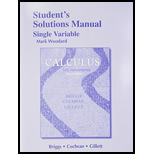
Concept explainers
Free fall An object in free fall may be modeled by assuming that the only forces at work are the gravitational force and air resistance. By Newton’s Second Law of Motion (mass × acceleration = the sum of the external forces), the velocity of the object satisfies the
where f is a function that models the air resistance (assuming the positive direction is downward). One common assumption (often used for motion in air) is that f(v) = – kv2 , where k > 0 is a drag coefficient.
a. Show that the equation can be written in the form v'(t) = g – av2, where a = k/m.
b. For what (positive) value of v is v′(t) = 0? (This equilibrium solution is called the terminal velocity.)
c. Find the solution of this separable equation assuming v(0) = 0 and 0 < v2 < g/a.
d. Graph the solution found in part (c) with g = 9.8 m/s2, m = 1, and k = 0.1, and verify that the terminal velocity agrees with the value found in part (b).
Trending nowThis is a popular solution!

Chapter D1 Solutions
Student Solutions Manual, Single Variable for Calculus: Early Transcendentals
Additional Math Textbook Solutions
A Problem Solving Approach To Mathematics For Elementary School Teachers (13th Edition)
Introductory Statistics
Algebra and Trigonometry (6th Edition)
Thinking Mathematically (6th Edition)
University Calculus: Early Transcendentals (4th Edition)
- practice problem please help!arrow_forward13. A restaurant will serve a banquet at a cost of $20 per person for the first 50 people and $15 for person for each additional person. (a) Find a function C giving the cost of the banquet depending on the number of people p attending. (b) How many people can attend the banquet for $2000?arrow_forwardAlt Fn Ctrl 12. Find functions f and g such that h(x) = (fog)(x). (a) h(x) = (x² + 2)² x+1 (b) h(x) = 5 3arrow_forward
